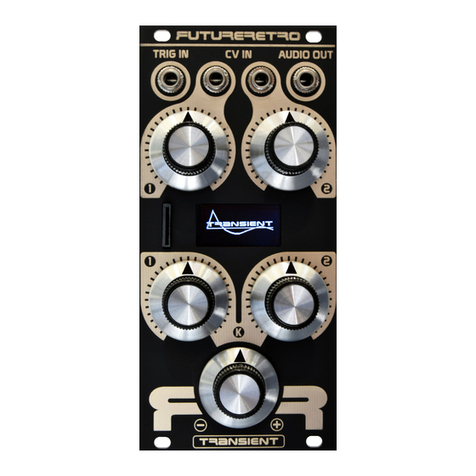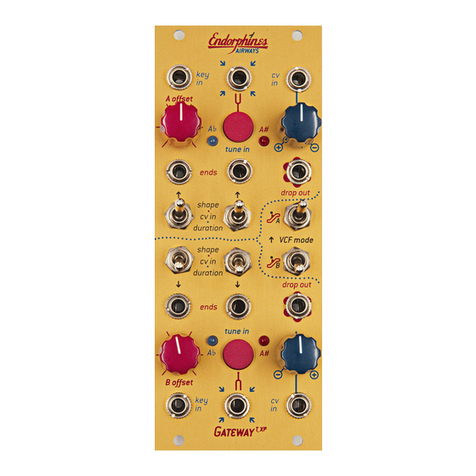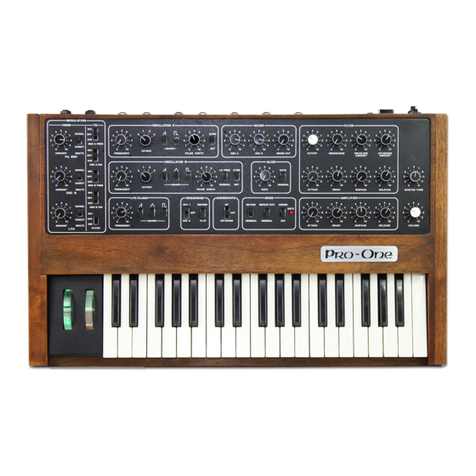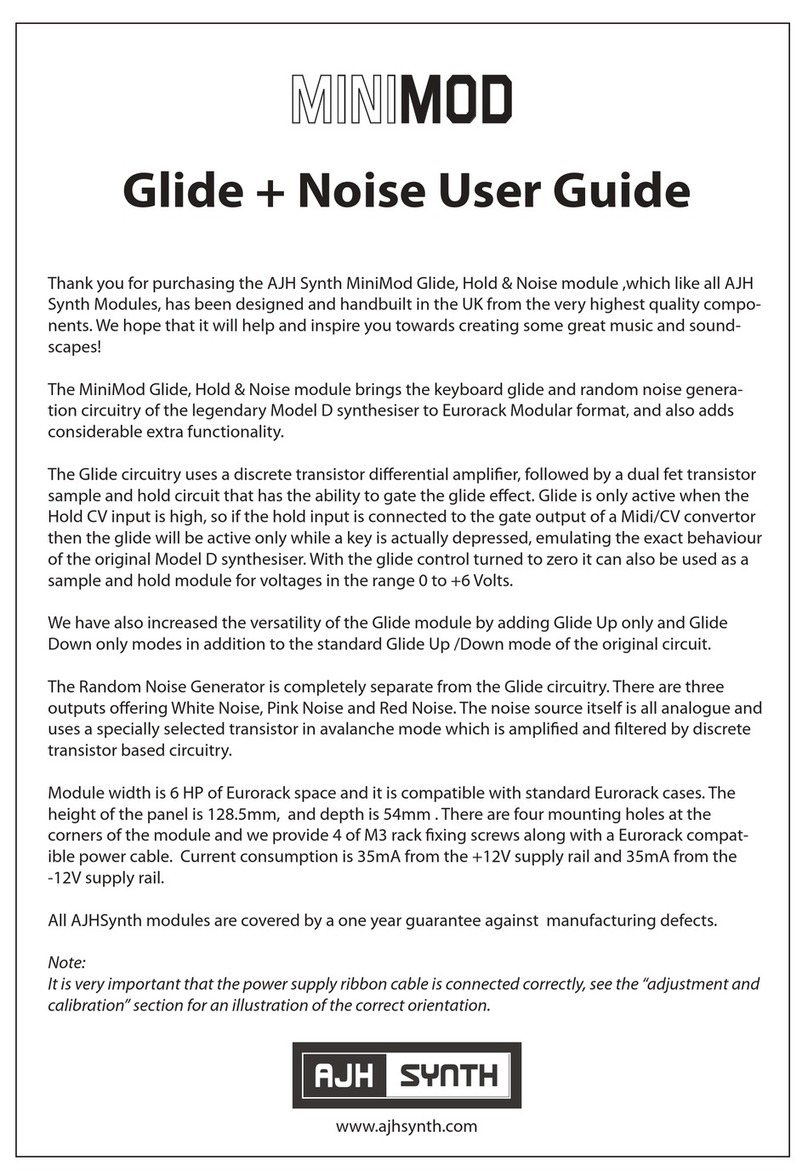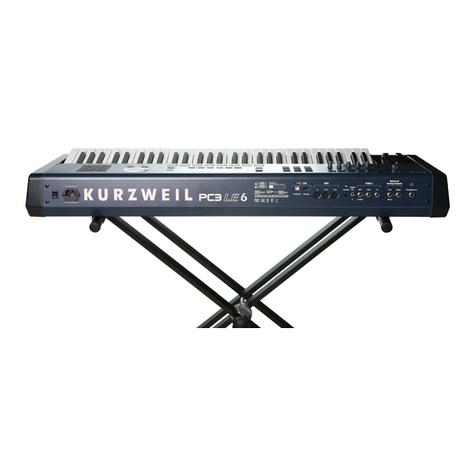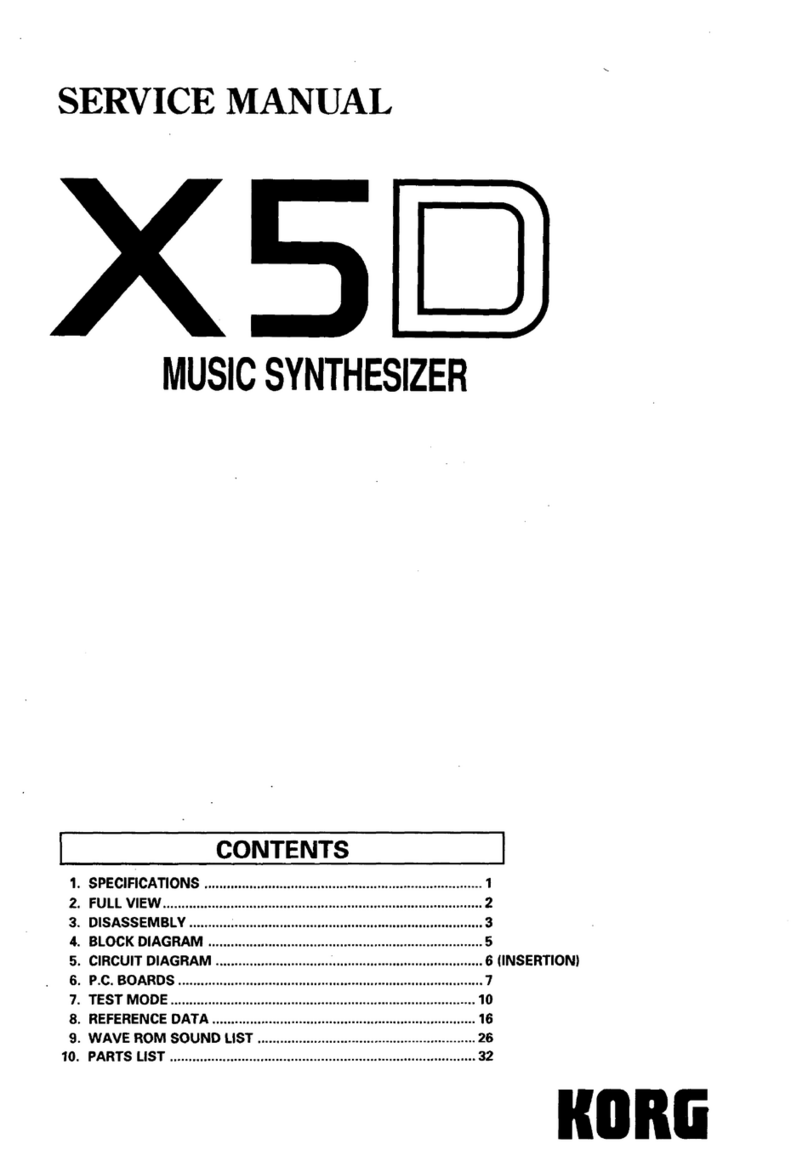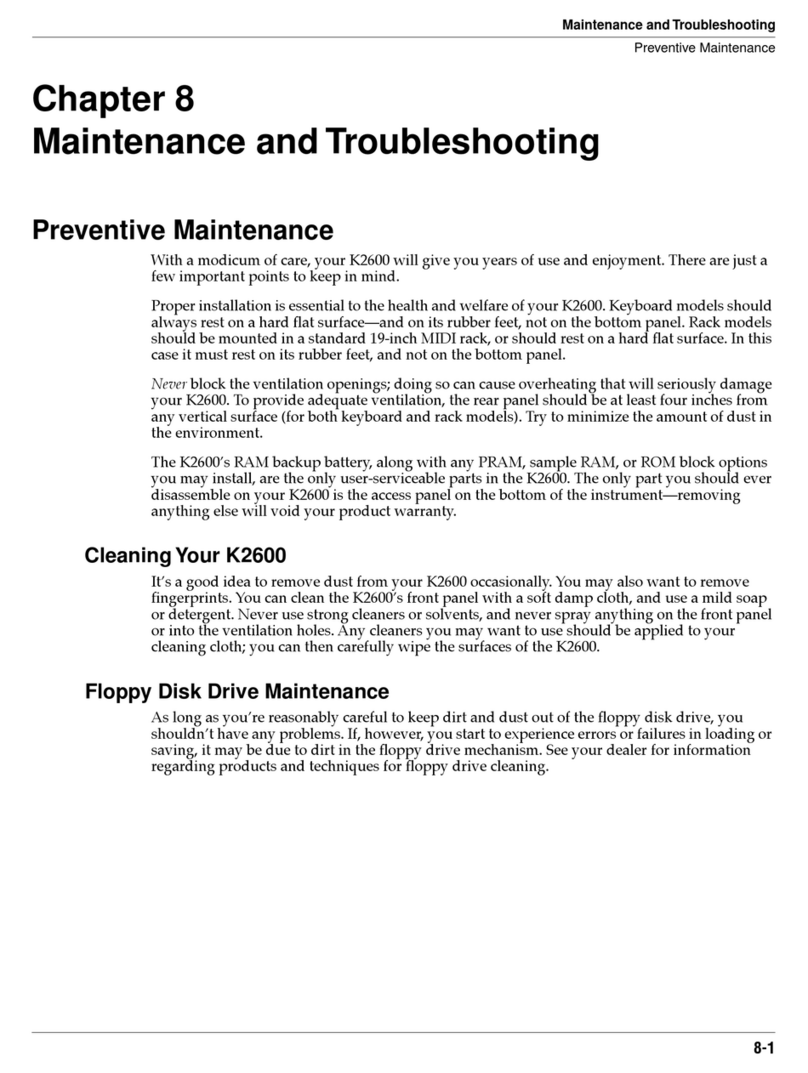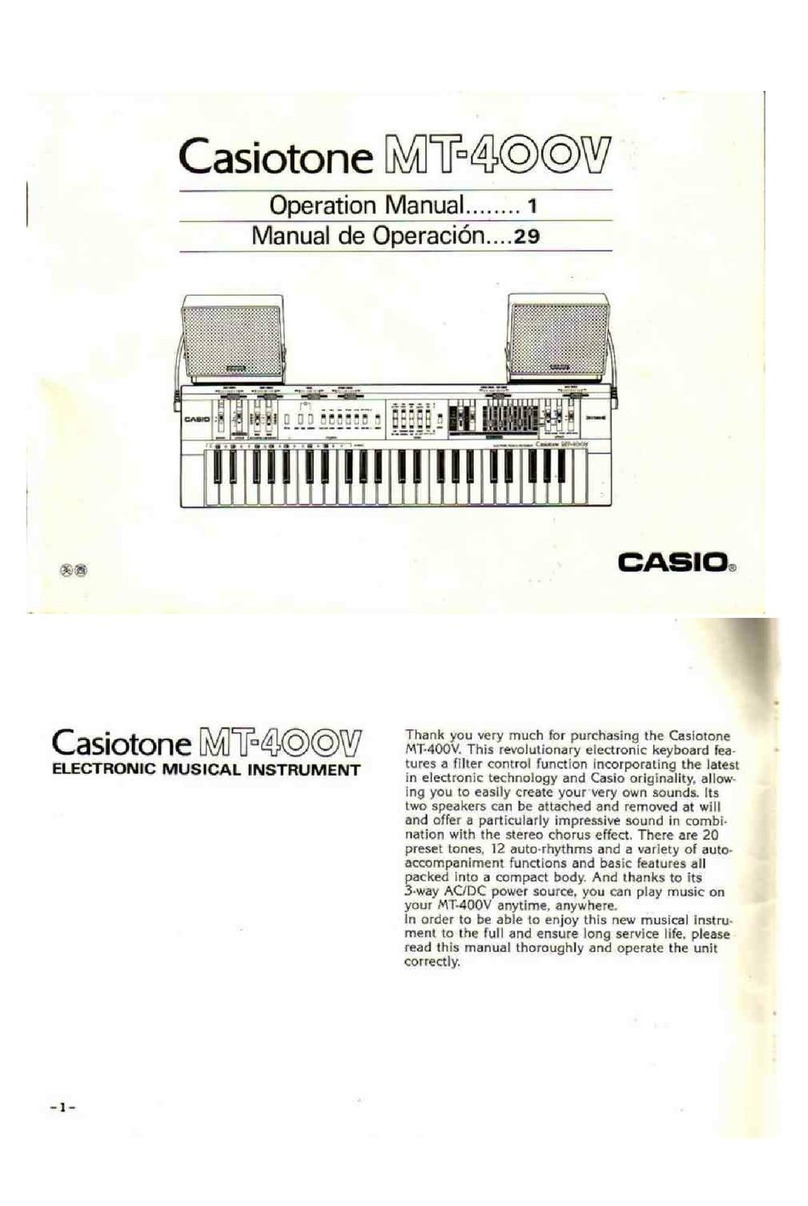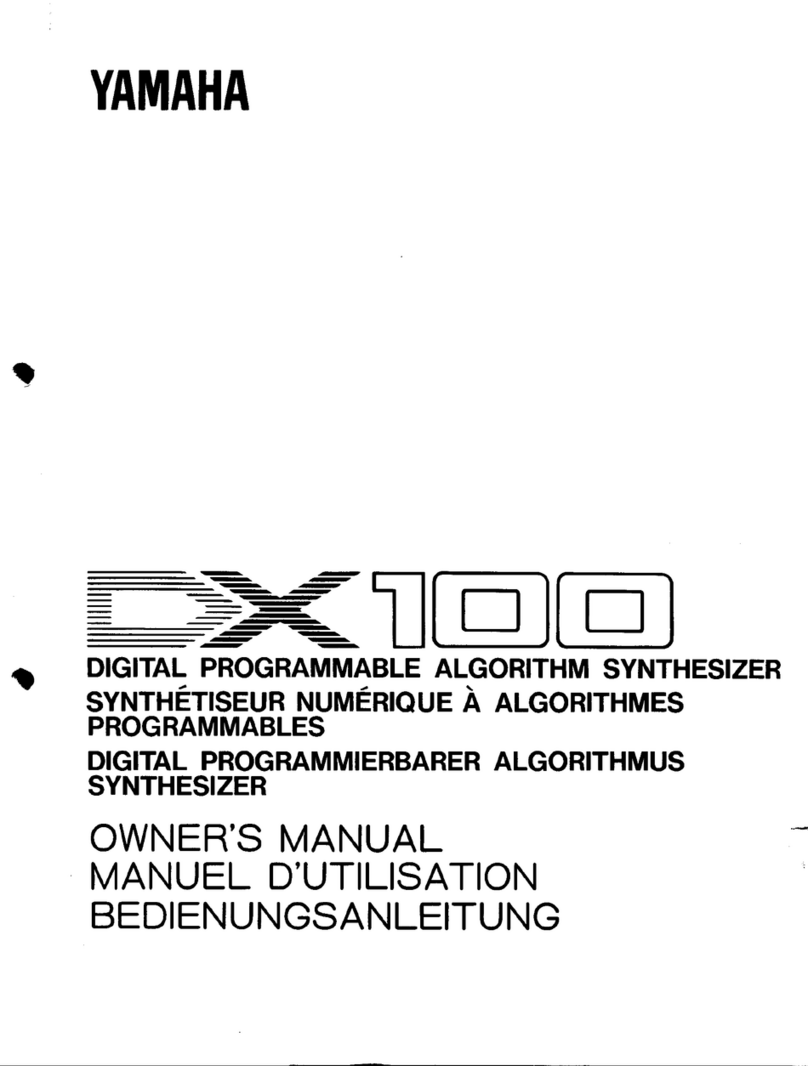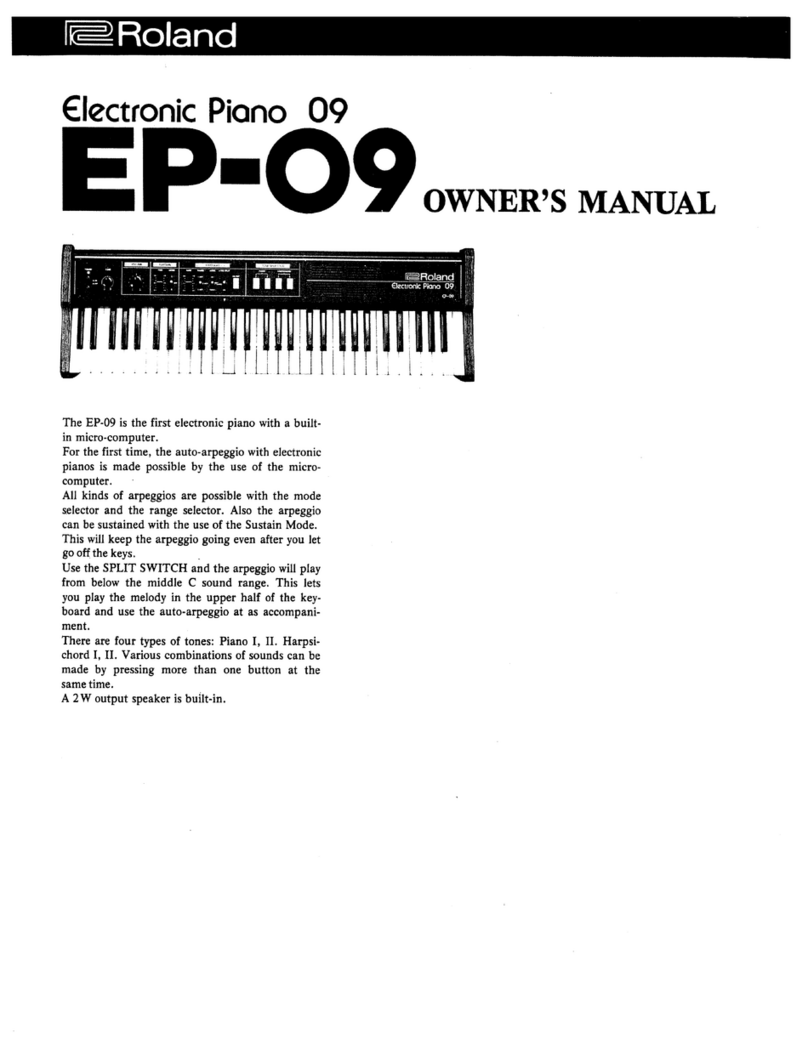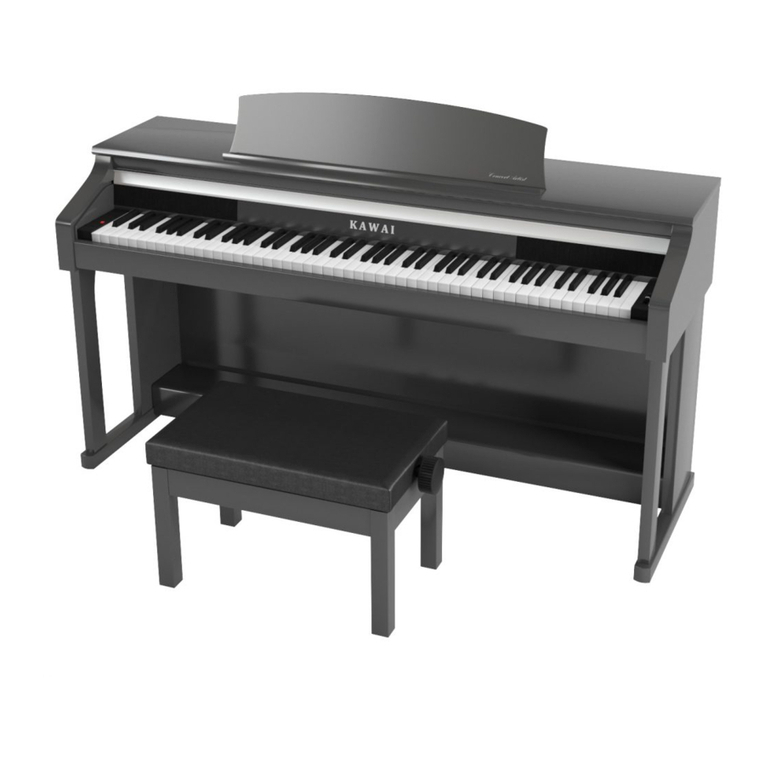Novatech 425A User manual

NOVATECH INSTRUMENTS 1 Rev 1.01, 425A Manual
INSTRUCTION MANUAL
Precision 350 MHz Synthesizer
Model 425A
Table of Contents
Section Page Contents
1.0 . . . . . . . . . . . . . . . . . . . . . . . . . . . . . 2 . . . . . . . . . . . . . . . . . . . . . . . . . Description
2.0 . . . . . . . . . . . . . . . . . . . . . . . . . . . . . 2 . . . . . . . . . . . . . . . . . . . . . . . Specifications
3.0 . . . . . . . . . . . . . . . . . . . . . . . . . . . . . 3 . . . . . . . . . . . . . . . . . Hardware Installation
4.0 . . . . . . . . . . . . . . . . . . . . . . . . . . . . . 3 . . . . . . . . . . . . . . . . . . . . . . . . . . .Operation
5.0 . . . . . . . . . . . . . . . . . . . . . . . . . . . . . 6 . . . . . . . . . . . . . . . . . . Theory of Operation
6.0 . . . . . . . . . . . . . . . . . . . . . . . . . . . . . 7 . . . . . . . . . . . . . . . . . . . . Performance Test
7.0 . . . . . . . . . . . . . . . . . . . . . . . . . . . . . 8 . . . . . . . . . . . . . . . . . . . . . . . . . .Calibration
--. . . . . . . . . . . . . . . . . . . . . . . . . . . . . . .10 . . . . . . . . . . . . . . . . . . . . . . . . . . . Warranty
--. . . . . . . . . . . . . . . . . . . . . . . . . . . . . . .10 . . . . . . . . . . . . . . . . . . . . . Option E, Errata

NOVATECH INSTRUMENTS 2 Rev 1.01, 425A Manual
1.0 DESCRIPTION
1.1 The Model 425A is a 48-bit Direct Digital Syn-
thesized (DDS) Signal Generator in a small shielded
table top case with an asynchronous serial control
port (RS232). The 425A provides sine wave, LVDS
and LVCMOS output signals, which can be set from
250 kHz to 350 MHz in steps of 10 Hz per LSB
when using the internal VCTCXO clock
1.2 Relative phase is adjustable over the same inter-
face with 14-bits of resolution. Amplitude can be
fine trimmed over a 10-bit range from approxi-
mately 0.14 to 0.50 V
rms
into 50 .
1.3 The LVCMOS output is optimized for frequen-
cies up to 125 MHz and, when used with its pro-
grammable divider, provides square wave clock
signals down to lower than 2 Hz.
1.4 The 425A can also be used with an External
Clock or Reference input. The external source can
either be a 10.0 MHz reference, which is phase-
locked internally, or a direct input of 250 to 1000
MHz. When used with the same external clock
source, multiple 425A remain phase synchronous.
2.0 SPECIFICATIONS
2.1 OUTPUTS
TYPES: Sine, LVDS and LVCMOS simultaneously.
IMPEDANCE: 50 (100 differential for LVDS)
RANGE: 250 kHz to 350 MHz with 10 Hz resolu-
tion (internal clock).
SINE AMPLITUDE: full scale approximately +7 dBm
(0.50 Vrms) into 50 load. Settable from 0.14 to
0.50 V
rms
by the “V0” command. (14-bit DAC). ±3dB
referenced to amplitude at 100 MHz.
2.2 LVCMOS AMPLITUDE
V
OL
<0.5 V, V
OH
>2.0 V into a series-terminated
load.
T
r,f
<2.5 ns. Duty Factor: 40-60% (divider off). 50
Programmable 16-bit divider with a selectable /2
prescaler allows LVCMOS frequencies below 2 Hz.
(LVCMOS optimized for frequencies <= 125 MHz)
2.3 LVDS AMPLITUDE
Meets EIA-644A specifications when terminated
into a 100 differential load (driver:
SN65LVDS100, or equivalent)
2.4 CONTROL
Output frequency (48-bits), phase (14-bits), CMOS
divider, and amplitude scaling (10-bits) are con-
trolled by a serial port. Settings can be saved in
EEPROM.
2.5 ACCURACY AND STABILITY
Accuracy: < ±1.5ppm at 10-40
o
C. Stable to an
additional ±2ppm per year, 18-28
o
C.
2.6 EXTERNAL CLOCK/REFERENCE IN
Direct external clock frequency range of 250 to
1000 MHz or locked to a 10.0 MHz (±0.01%) refer-
ence. The 425A specifications depend upon the
quality of this signal.
Input Level (50 :
10 MHz Reference: 0.75-1.25 Vrms Sine or LVC-
MOS Square Wave.
External Clock: -3 to +6 dBm sine wave.
2.7 SPECTRAL PURITY
(Typical, 50 load, int.
clock)
Phase Noise:<-140 dBc, 10 kHz offset, 10 MHz out.
Spurious: <-70 dBc below 10 MHz
<-60 dBc below 50 MHz
<-55 dBc below 150 MHz
<-45 dBc below 350 MHz
Harmonic: <-65 dBc below 1 MHz
<-60 dBc below 10 MHz
<-55 dBc below 25 MHz
<-45 dBc below 50 MHz
<-40 dBc below 150 MHz
<-25 dBc below 350 MHz
2.8 POWER REQUIREMENTS
+4.75 to +5.25 V @ <750 mA. 2.5 mm center-
positive connector on rear panel. AC line (country
dependent) adapter provided.
2.9 SIZE
39 mm H, 107 mm W, 172 mm L, not including con-
nectors.
2.10 CONNECTORS
BNCs for SINE Out, LVCMOS Out, LVDS out, REF
IN. 2.5 mm center positive barrel connector for
Power. DE9 for serial control.

NOVATECH INSTRUMENTS 3 Rev 1.01, 425A Manual
3.0 HARDWARE INSTALLATION
3.1 Power Connection. Figure 1, shows the rear
panel of the 425A. The required power of +5 Volts
DC is applied through a 2.5mm center positive bar-
rel connector.
3.2 The quality of your power supply may affect the
performance of the 425A. The supply should be free
of ripple and noise (typically <50 mV). Even though
extensive filtering is used on the 425A board, a quiet
and well regulated power supply will ensure opti-
mum performance. If power supplies, other than the
Novatech Instruments provided one, are used, please
verify that your system noise requirement is met.
3.3 Internal Clock. If you plan to use the 425A
internal clock, which is the default mode, no setup
action is required. The on-board VCTCXO is multi-
plied in a phase-locked loop (PLL) to generate the
internal master clock for the DDS ASIC.
3.4 External Clock. There are two customer-sup-
plied clock modes. One (external reference select,
“C r”) uses an internal PLL to multiply an external
10.0 MHz reference to provide a 940.0 MHz master
clock. The other mode (external clock select, “C
e”) allows a 250 to 1000 MHz direct input. In this
mode, the PLL is disabled and the customer clock is
directly used as the master clock.
3.5 If you are providing an external clock or exter-
nal reference, apply your signal to the REF IN BNC
connector on the rear panel. Carefully observe the
amplitude requirements for each mode. Note that
phase noise and stability of the 425A are dependent
upon your supplied clock. Send the appropriate
clock select command to enable your input. This
automatically configures the internal clock circuitry
to generate the correct master clock.
3.6 Unless your external clock is an exact binary
multiple, non-fractional frequency steps will not be
possible, and your frequency settings will need to be
scaled. See Section 4.0, Operation, for scaling infor-
mation.
NOTE:
Consult Novatech Instruments if you require locking
to an external 10.00 MHz standard without round-
off.
3.7 Serial Port Interface Installation. The 425A is
controlled by using an asynchronous serial port
(RS232). Direct connections can be made from most
PCs using a 9-pin monitor extension (male to
female) cable or by using a USB to RS232 (DE9)
adapter. The rear panel connector is a 9-pin female.
3.8 If you are using a different computer, terminal
or other control source, please note that the data TO
the 425A is on pin 3; the data FROM the 425A is
on pin 2 and the COMMON return is on pin 5. Set
your host to 19.2 kBaud, 8 bits, 1 stop bit, no
parity and no hardware flow control.
3.9 Signal Outputs. There are three signal outputs
on the 425A: one channel each of Sine, differential
LVDS and LVCMOS. The outputs are provided on
front panel BNC receptacle connectors. Simply con-
nect your application cables to appropriate output.
The LVDS output requires 100 differential termi-
nation at the destination (internal driver:
SN65LVDS100 or equivalent). All the outputs are at
the same frequency, unless the divider (D0 and PR)
commands have been issued. The LVCMOS output
frequency depends upon the divider and prescaler
settings.
3.10 See Figures 3 and 4 for typical termination of
the LVDS and LVCMOS signals.
NOTE:
The LVCMOS signal is disable by default. Use the
“A e” command to enable it.
Figure 1: Rear Panel

NOVATECH INSTRUMENTS 4 Rev 1.01, 425A Manual
Serial Command Function
F0 xxx.xxxxxxxxxxx Set Frequency of output in MHz to nearest 10 Hz. Decimal point
required.
P0 N Set relative Phase of output sinewave. N is an integer from 0 to 16383.
Phase is set to N*360
o
/16384 or N*2/16384 radians. This is useful
when multiple Model 425A are running from the same clock source.
E x Serial echo control. x=D for Echo Disable, x=E for Echo Enable. Dis-
able echo for maximum serial port speed.
C x Select clock source. x=E for External 250 MHz to 1000 MHz direct
input; x=R for 10.0 MHz Reference; x=I for Internal temperature com-
pensated reference. The quality of the external reference affects the
specifications of the 425A. The “F0” command requires scaling (see
manual) for clocks other than the internal oscillator.
RReset. This command resets the 425A. EEPROM data is preserved
and, if valid, is used upon restart. This is the same as cycling power.
CLR Clear. This command clears the EEPROM valid flag and restores all
factory default values.
A x x=E for LVCMOS Enable, x=D for LVCMOS Disable. Default setting
is “D.”
D0 N Set Divider value on LVCMOS output. N is an integer from 0 to
65535. The output frequency set by the “F0” command is divided by
N+1 before being sent to the LVCMOS driver.
PR x x=E for Enable Prescaler, x=D for Disable Prescaler. When enabled,
the frequency set by the “F0” command is divided by 2 before enter-
ing the LVCMOS divider specified by the “D0” command. This
allows a maximum divide integer of 131072.
SSaves current state into EEPROM and sets valid flag. The saved state
is used as the initial values upon next power up or reset. Use the
“CLR” command to return to default values.
QUE Return present frequency, phase and status. Returns a character string
of all internal settings.
M N Mode command. Mode ‘M 0’ is single tone. (Only Mode 0 is
implemented at software Rev 1.5.)
V0 N Set Voltage level of output. In default, the amplitude is set to the
maximum of approximately 0.5 V
rms
(+7 dBm) into 50 N can range
from 0 to 1023 (no decimal point allowed). Voltage level is scaled
(multiplied) by:
0.27 + 0.19*N/264
If N >1023, the command is ignored and the level remains at its
previous setting (approximately 0.14 V
rms
to 0.50 V
rms
).
I x Set the I/O update pulse method. If x=a, then an I/O update is issued
automatically at the end of each serial command (default). If x=m, then
a manual I/O update pulse is expected to be sent by a subsequent
‘I p’ command.
B aabb[cc[dd[ee[ff[gg[...]]]]]]] This Byte command allows each register in the DDS chip to be set.
Different registers require a various number of bytes to be written
depending upon the instruction word “aabb”. Note that it is possible
to set the DDS chip into a non-functional mode, requiring a power
cycle to recover. All values are in hexadecimal and no error checking,
other than correct format, is performed.

NOVATECH INSTRUMENTS 5 Rev 1.01, 425A Manual
4.0 Operation
4.1 Power on reset. After power is applied, the
425A takes approximately 300 ms to perform its ini-
tialization sequence. Any communication during
this time will be ignored or may cause erroneous
operation.
4.2 Specifications are met within 15 minutes of
power-up in stable environment.
4.3 After the 425A has been installed in the cus-
tomer application system, all that is required for
operation is to send the appropriate data.
4.4 Serial commands are shown on the previous
page. The commands consist of a one or two charac-
ter alpha-numeric mnemonic separated from the
operand by a space. Some commands do not have an
operand, so the space is not necessary.
4.5 To facilitate use with various systems, the com-
mands can be terminated by a line feed (LF), car-
riage return (CR) or any combination.
4.6 The user host hardware must properly format
the asynchronous serial port data. Incorrect format-
ting will result in erroneous or erratic operation. See
Table 1 for Serial Error Codes. Not all error codes
are used in all versions.
4.7 If you are using an external clock, the frequency
value sent to the 425A command must be scaled.
4.8 The nominal Internal Clock has a value that pro-
duces a even step size of 10.0 Hz. Thus a scale fac-
tor is necessary to determine your exact output
frequency when using external clock sources. For
example, to obtain 10 MHz output when using a 10
MHz reference (940.0 MHz internal master clock),
your frequency setting would be:
F
setting
= F
desired
*0.998138215286 MHz
F
setting
= 9.98138215286
send: F0 9.98138215286
4.9 When used with an external clock of 250 MHz
to 1000 MHz (“C e” command), your setting will
be given by:
F
setting
= F
desired
*938.249922368853/(F
clk
) MHz
where F
clk
is your external clock in MHz.
NOTE:
You must account for your external clock frequency
accuracy and calculation round-off when using an
external clock. Most calculators have less than 48-
bits of resolution.
The noise and accuracy specifications are directly
affected by the quality of the external source. Unless
care is exercised, your specifications may be
degraded. Please verify your system requirements
with the chosen clock mode.
4.10 For example, if you were using an OC-12
clock of 622.08 MHz, and desire a 10 MHz output,
your calculation will be:
F
setting
= F
desired
*938.249922368853/(F
clk
) MHz
= 10.0*938.249922368853/622.08
= 15.08246402985
Send: F0 15.08246402985
4.11 Since the internal frequency resolution of the
425A is 48-bits, the typical fractional frequency
error (f/f) for output frequencies in the MHz range
will be on the order of 1x10
-12
, even when exact val-
ues are not possible due the round-off from the
external clock scaling. For the example, the 10.00
MHz error will be approximately 2 Hz when using
an external 10 MHz clock, resulting in 2x10
-13
f/f.
Table 1: Serial Error Codes
Error Code Meaning
OK Good command received (not sent for
R, CLR and QUE)
?0 Unrecognized Command
?1 Bad Frequency
?2 Bad AM Command
?3 Input line too long
?4 Bad Phase
?5 Bad Time
?6 Bad Mode
?7 Bad Amp
?8 Bad Constant
?f Bad Byte

NOVATECH INSTRUMENTS 6 Rev 1.01, 425A Manual
For many applications, this magnitude of the devia-
tion will be insignificant.
NOTE:
The frequency command is limited to a maximum
value of approximately 469.1 MHz, 50% of internal
clock. The filter -3dB cut-off is set to 375 MHz.
Distortion and roll-off will increase beyond 350
MHz, but the outputs may still be usable in your
application.
4.12 The relative phase of the output is settable to
14-bits of resolution. The relative phase shifts by:
Phase
out
= (P
setting
)*360
o
/16384
P
setting
= 0 to 16383.
4.13 The amplitude of the sine output can be
adjusted using the “V0 N” command. The 50 ter-
minated output amplitude as a function of the V0
setting is given by:
Amplitude = 0.5*[0.27+0.19*N/264] V
rms
approximately 0.14 to 0.5 V
rms
.
4.14 The LVCMOS output has a divide-by-2 pres-
caler followed by programmable 16-bit divider,
which allows the sinewave frequency to be divided
by integers up to 131,072. Your application fre-
quency may be created by various combinations of
the F0, D0 and Pr commands. You should experi-
ment to find the best performance range for your
application.
4.15 For example, if you desired a clock signal of
1.00 kHz, you could obtain it by setting F0 to 10.00
MHz and using at D0 value of 9,999.
4.16 The duty cycle of the LVCMOS output is
dependent upon the divide ratio. Odd divider values
(even D0 command values) give output symmetry
furthest from 50%. For example, a divide of 3 (“DO
2”) will result in a 33% duty factor. Even values
produce symmetrical duty cycle outputs. The pres-
caler setting does not affect the duty factor, since it
is before the programmable divider.
4.17 When the LVCMOS output is enabled, the
divider is set immediately upon the end of com-
mand. It is unaffected by the “I” command set-
tings.
NOTE:
The relative phase of the LVCMOS output with
respect to the Sine output is dependent upon
frequency and divide ratio settings.
4.18 A Baud rate command is available if you wish
to set a Baud rate different than the default value.
The value set by this command is volatile and not
saved in EEPROM to prevent loss of communica-
tion. Upon power up, reset or clear, the 425A reverts
to 19.2 kBaud.
4.19 Kb command examples, with the value in
hexadecimal:
Kb 78 ;9.6 kBaud
Kb 3c ;19.2 kBaud
Kb 1e ;38.4 kBaud
Kb 14 ;57.6 kBaud
Kb 0a ;115.2 kBaud
4.20 Depending upon your system requirements,
you may wish to enable non-standard Baud rates.
The formula for the Kb setting is:
Baud Rate = 1152/N kBaud
where N is the decimal value of the Kb command
hexadecimal value. N=0 is not allowed.
NOTE:
You will need to verify non-standard baud rates in
your system. Consult Novatech Instruments
regarding permanent setting of 115.2 kB.
4.21 The “QUE” command returns a two-line hexa-
decimal string which represents the present instru-
ment state. The default return values are:
02BA7DEF3000 0000 03FF 000000
2100 15
The meanings are:
02BA7DEF3000: binary 48-bit frequency
(scaled by 3 from serial input value)
0000: binary phase (max: 3FFF)
03FF: binary amplitude setting (max: 03FF)
000000: binary divider value (max FFFF)

NOVATECH INSTRUMENTS 7 Rev 1.01, 425A Manual
(Leading byte: 01=prescaler on)
2100: internal control registers
15: software revision as x.y, (1.5)
5.0 Theory of Operation
5.1 Please refer to the simplified System Block Dia-
gram in Figure 2 for the following discussion.
5.2 At every cycle of the 425A master clock, the 48-
bit Direct Digital Synthesizer (DDS) integrated cir-
cuit increments the phase of an internal accumulator
by a value determined by the frequency setting
loaded into the on-chip registers. This digital phase
value is converted on-chip to a sinusoidal amplitude
level and delivered to an on-chip 14-bit digital-to-
analog converter. The analog signal from this con-
verter is filtered by a 7th-order elliptical low pass
reconstruction filter, amplified and sent to the SINE
output connector.
5.3 The amplified Sine signal is diverted to a high-
speed zero crossing detector to generate the LVDS
output signal. The output of the detector is fed back
into the DDS IC to supply the clock for the internal
programmable divider.
5.4 The frequency generated by the DDS IC is
determined by the binary 48-bit frequency word
loaded into the frequency register on the 425A. The
output frequency is given by:
F
out
= F
binary
*(100/3)*F
clock
/2
48
Hz
Where: F
clock
= 28,147,497.6710656 Hz (int.)
F
binary
= Binary value in DDS IC.
(F
binary
ranges from 0 to 2
47
-1)
This reduces to:
F
out
= F
binary
*3.3333Hz
for the internal (default) clock settings. The binary
setting is the customer’s input setting scaled by a
factor of three and converted to a binary value with
the LSB having a weight of 10 Hz.
5.5 Since the DDS IC is a sampled data system, the
output frequency is limited to a maximum of 1/2 the
system clock frequency (F
binary
<=2
47
-1). While it is
possible to generate an output near 50% of the clock,
the distortion may be unacceptable. Therefore, the
output is limited to approximately 40% (approxi-
mately 350 MHz) of the system clock and a 7th-
order elliptical output filter is implemented on
board.
6.0 PERFORMANCE TEST
6.1 Install the 425A as directed in Section 3. Con-
nect your host controller and operate the 425A per
Section 4. The test limits assume a stable environ-
ment of 18-28
o
C.
NOTE:
Allow the 425A to warm up for at least 15 minutes
before performing any measurements. For best
results, the 425A should be verified in an
environment similar to its application.
6.2 See Table 2 for a list of recommended test
equipment to perform the following measurements.
6.3 Verify Frequency Accuracy. To verify the fre-
quency of the 425A, set the output sequentially to
each value in Table 3, with the clock source set to
internal (“C i”). Connect the recommended fre-
quency counter set to 50 termination and 0.1 Hz
resolution. Verify the limits show in Table 3. If you
do not use an external frequency standard for the
frequency counter, be sure to add the error of your
Table 2: Recommended Test Equipment
Item
Minimum
Specification Recommended
Oscilloscope 500MHz, 50Tektronix
TDS3052C
Frequency
Counter
350MHz HP53132A
Counter Time
Base
10MHz,
<
±
0.1ppm
Novatech
Instruments
Model 1450B
External Clock 250-1000
MHz
Customer
supplied

NOVATECH INSTRUMENTS 8 Rev 1.01, 425A Manual
counter to the tolerance. (LSD = Least Significant
Digit on counter).
6.4 Sine Out Amplitude Verification. Set the fre-
quency of the 425A to 10 MHz. Connect the 425A
Sine Out to the oscilloscope set for 50 termina-
tion. Set the oscilloscope to measure to RMS voltage
using at least 16 averages. Verify a reading of 0.5
Vrms
±
0.1 Vrms.
6.5 Output Flatness Verification. Verify that the
outputs are flat with frequency by performing the
following test: Connect the 425A Sine Out to the
oscilloscope set for 50 termination. Use the same
setting up as the Sine Out Amplitude Verification.
Note the 100 MHz voltage reading.
6.6 Set the 425A to the values of Table 3. Verify
that the oscilloscope amplitude reading remains
within
±
3dB (a multiple of 1.414 to 0.707) of the
value noted in the previous paragraph.
6.7 External Clock Input Verification. Connect a
10.0 MHz external clock source via a short coaxial
cable to the REF IN BNC on the 425A rear panel.
Issue the “C r” command. Set the frequency to 10
MHz without scaling. Verify that your reference sig-
nal meets the requirements in the specifications.
Verify an output frequency reading of
10.0186525742 MHz. You will need to account for
the accuracy of your 10.00 MHz source and your
frequency counter.
6.8 If you are using a clock source of 250 MHz to
1000 MHz, you will have to calculate the proper
scaling per Section 4.
6.9 This concludes the verification test of the 425A.
7.0 CALIBRATION
7.1 The 425A has two user adjustable components:
Y2, frequency, and R37, output amplitude. Calibra-
tion should be performed only if the 425A fails the
performance test or if the unit has been repaired.
Routine adjustments are not recommended nor gen-
erally required. This procedure assumes that the
425A has failed the performance test or has been
repaired.
WARNING:
Calibration should be performed only by qualified
personnel. The on-board components are static
sensitive.
7.2 The adjustments shown are set to 1/2 the speci-
fication values.
NOTE:
Allow the 425A to warm up for at least 15 minutes
before performing any adjustments. For optimum
performance the 425A should be calibrated in an
environment similar to its installation.
7.3 Frequency Adjust, Y2. Set the output of the
425A to 10.000000 MHz. Connect your frequency
counter with its input set for 50 termination.
Adjust Y2 using a non-metallic adjustment tool for
10.000000 MHz, ±7.5 Hz.
7.4 Amplitude Adjust, R37. Connect the Sine out-
put to the oscilloscope set to measure RMS voltage,
with a minimum of 16 averages. Set the oscilloscope
for 50 input termination. Leave the 425A output
set to 10.00 MHz. Adjust R37 for 0.5 Vrms ±0.05
Vrms.
7.5 This completes the calibration of the Model
425A.
Table 3: Frequency Test Points
Frequency Tolerance
250 kHz
±
0.375 Hz
±
1 LSD
1 MHz
±
1.5 Hz
±
1 LSD
10 MHz
±
15 Hz
±
1 LSD
30 MHz
±
45 Hz
±
1 LSD
50 MHz
±
75 Hz
±
1 LSD
100 MHz
±
150 Hz
±
1 LSD
150 MHz
±
225 Hz
±
1 LSD
250 MHz
±
375 Hz
±
1 LSD
350 MHz
±
525 Hz
±
1 LSD

NOVATECH INSTRUMENTS 9 Rev 1.01, 425A Manual
POWER
LOGIC
48-Bit
DDS,
LP Filter AMP SINE
OUT
Buffer LVCMOS
OUT
POWER
FILTERS &
+5V
-5V
Master
Clock
EXT
CLK
IN
CLK SEL
Figure 2.
Simplified System Block Diagram
425A
Serial CSystem Control
+1.8V
REGULATOR
AD9912
+5V
+3.3V
Buffer LVDS
OUT
+
-
100
Typical LVDS Driver, SN65LVDS100
Customer Supplied
LVDS+
LVDS-
50
Series Terminated LVCMOS
Customer Application
425A
50
Figure 3.
Figure 4.

NOVATECH INSTRUMENTS 10 Rev 1.01, 425A Manual
425A MANUAL ERRATA
OPTION /E, Remote Clock
Option E makes it possible to use multiple 425A and have the outputs from these 425A be phase
synchronous. Model 425A with Option E installed has the internal master 28MHz oscillator removed and
two rear mounted SMA connectors installed. One of the rear mounted SMA connectors, labeled CLK IN,
accepts a 28MHz clock signal from the 450A Clock Distribution Amplifier. The other rear mounted
SMA connector labeled IOUD is intended to enable a future feature. When option E is installed on a
425A, the user needs to connect the 28MHz internal clock signal from a Model 450A Clock Distribution
Amplifier to the 425A CLK IN SMA connector on the rear of the 425A and the 425A must be configured
for internal clock (C x command where x=I, see table on page 4).
CAUTION: The 425A rear SMA connectors are intended for use with low voltage signals. Do not apply
a voltage over 5.7Vpp AC on the CLK IN connector or you may damage the 425A.
WARRANTY
NOVATECH INSTRUMENTS warrants that all instruments it manufactures are free from defects in
material and workmanship and agrees to replace or repair any instrument found defective during a
period of one year from date of shipment to original purchaser.
This warranty is limited to replacing or repairing defective instruments that have been returned
by purchaser, at the purchaser's expense, to NOVATECH INSTRUMENTS and that have not
been subjected to misuse, neglect, improper installation, repair alteration or accident.
NOVATECH INSTRUMENTS shall have the sole right to final determination regarding the existence
and cause of a defect.
This warranty is in lieu of any other warranty, either expressed or implied, including but not
limited to any warranty of merchantability or fitness for a particular purpose. In no event shall seller
be liable for collateral or consequential damages. Some states do not allow limitations or
exclusion of consequential damages so this limitation may not apply to you.
All instruments manufactured by NOVATECH INSTRUMENTS should be inspected as soon
as they are received by the purchaser. If an instrument is damaged in shipment the
purchaser should immediately file a claim with the transportation company. Any instrument
returned to NOVATECH INSTRUMENTS should be shipped in its original shipping container or
other rigid container and supported with adequate shock absorbing material.
This warranty constitutes the full understanding between NOVATECH INSTRUMENTS and
the purchaser and no agreement extending or modifying it will be binding on
NOVATECH INSTRUMENTS unless made in writing and signed by an authorized official of
NOVATECH INSTRUMENTS.
NOVATECH INSTRUMENTS
United States of America
Voice: 206.301.8986
http://www.novatechsales.com
sales@novatechsales.com
Table of contents
Other Novatech Synthesizer manuals

